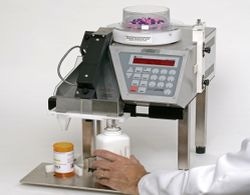Benefits of Compact Tablet Counters
August 19, 2009

By Michael Stotz
When it comes to tablet and capsule manufacturing for the dietarysupplement industry, bigger is not always better. For many scenarios inthe manufacturing of vitamins, dietary supplements and nutraceuticals,the right technology is not a multi-million dollar packaging line. Theright technology, in fact, can be a simple tablet counter andsemi-automated bottle-filling device. For instance, small countingtechnology is perfect (and perfectly affordable) for:
quality checks on the packaging line or in the R&D lab;
low- to mid-volume bottling where it is not practical to use a full-scale production line;
inventory counts; or
finishing a bottling run from an automated filling line.
Tabletcounters arent new technology, and have been in active use since the1970s. But the accuracy and reliability of these devices hascontinually improved. Today, hundreds of dietary supplement andpharmaceutical manufacturers and laboratories have a tablet counterrunning in harmony with their full-scale filling lines. These companieshave benefited from increased packaging speed, accuracy and peace ofmind.
There are several examples where a small counting devicemay be ideally suited. First, consider its usefulness in qualityassurance (QA) and quality control (QC) on the packaging line or in anR&D laboratory. Whatever the form of hand-countingcounting trayand spatula or peg boardit is inherently inaccurate. A 2004 studyconducted by the Thomsen Group found humans are at best 95 percentaccurate in hand-counting medications with a counting tray and spatula.That accuracy rate drops precipitously with sub-par lighting,distractions and workload. A tablet counter, on the other hand, isclose to 100 percent accurate. It counts any size or shape tablet orcapsule. Many tablet counters are small enough to be carted around thefacility and are inexpensive enough to be placed near every bottlingline.
Additionally, as with QC checks, using a tablet counterinstead of hand-counting can cut significant time during an inventoryprocess, not to mention eliminate a highly tedious task. Some tabletcounters are hands-free and allow the technician to multi-task whilethe device handles the counting.
Another prime example is in thecase of low- to mid-volume bottling where it is not practical to use afull-scale production line. For production runs of 50 bottles to a fewthousand bottles per day, a smaller device is ideal, particularly forcontract manufacturers that find they turn away smaller businessbecause they cant afford to disrupt their automated production lines.Or for manufacturers that are bringing manufacturing back inside, butneed to watch capital expenditures; or for clinical trial filling.These devices handle any size and shape tablet or capsule; many need nocalibration to change between orders. They also accommodate any sizebottle or vial. Cleaning between runs takes less than five minutes.These are simple devices to set up, learn and operate.
Finally,consider how the use of such a small device could assist in finishing abottling run from an automated filling line. The end of a bottling runon a fully automated bottling system may result in uneven amounts ofproduct in each filling line or slat. Semi-automated bottle fillingdevices allow the lot to be completed efficiently and quickly. Thiseliminates waste and ensures accuracy.
On top of these specificscenarios, there are many benefits of simple, yet highly accuratetablet counters and bottle filling devices.
Low price point:A simple tablet counter for foolproof check counting can run less than$6,000. A semi-automated bottling device capable of counting andfilling 800 up to 1,900 tablets per minute costs from $7,500 to $15,000.
Tiny footprint:Taking up less than 1.5 square feet, requiring almost no remodeling,and frequently are light enough to be wheeled around on carts toservice more than one filling line.
Easy to install and learn:They can be taken out of the box and be working in fewer than 10minutes. This means no downtime, complicated tutorials or staffdissatisfaction.
Clean in minutes, not hours, and need no calibration for different types of medications.
No need for technology support: No tricky interfacing to add complexity to the project, and no incremental connection costs.
Whenlooking at options, there are several considerations. Ideally, look fora counter with few or no moving parts, as the less complex devices haveless chance of breaking down. Also, ask about cleanup requirements(straight water versus mandatory cleaners), including the timenecessary for cleanup. Price is also a consideration. These devices aredesigned to be simple to acquire and to operate; however, consider alsopurchasing an annual service contract to cover the bases. While usedequipment may seem like it offers advantages, often they come without awarranty and may be missing parts or operating manuals.
Still notconvinced? Many suppliers will offer a free trial of the device, toallow companies to use them in real-world applications. In most cases,the results are positive: faster production, fewer errors and lesslabor. In some applications, semi-automatic counter-fillers pay forthemselves in a few months.
Michael Stotz is the manager of business development for Kirby Lester LLC,Lake Forest, IL, a leading supplier of pharmacy and pharmaceuticalautomation products. Stotz has spent 19 years in the pharmaceutical andpharmacy markets in a variety of communications, marketing and trainingroles; he can be contacted at (847)984-0320 or [email protected].
You May Also Like